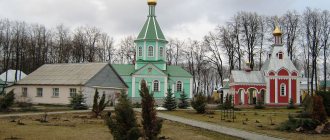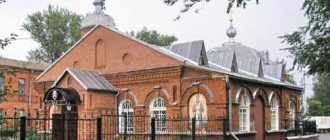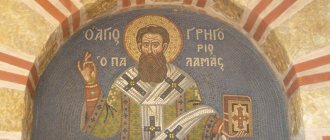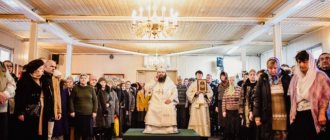Memorial Day: November 28 (December 11)
Saint Seraphim (in the world Chichagov Leonid Mikhailovich) came from a famous aristocratic family, famous in Russian history for its outstanding figures, including military men, among whom were two admirals. Leonid was born on January 9, 1856, in the city of St. Petersburg.
His father, Mikhail Nikiforovich, was an artillery colonel, and for obvious reasons wanted his son to have a similar career. Meanwhile, when Leonid was only ten years old, his father died, and his mother, Maria Nikolaevna, took on all the responsibilities for supporting and raising his son (and his three brothers).
After some time, driven by the desire to establish a military career for her sons, she assigned Leonid and his two brothers to the Corps of Pages, a military educational institution known at that time in Russia. A year before completing his studies in the Corps of Pages, Leonid received the rank of chamber page, and after graduating at the age of 18, he entered the Artillery Academy, after which he went into military service.
In 1877, he found himself in the Balkans, where he participated in the bloody Russian-Turkish battles - at the Shipka Pass, as well as in the capture of Telesh and Plevna. The courage and heroism shown by Leonid in the war were awarded with military awards. God's providence saved him from possible death.
Upon returning from the front to peaceful St. Petersburg, he was so strongly impressed by his experience in the war that he wrote several books on this subject: about the heroism of Russian soldiers, about the meaning of life, about death. In addition, deeply moved by the suffering of wounded soldiers he saw, he began to study medicine, which resulted in the two-volume work “Medical Conversations.”
In 1878, L. M. Chichagov had a meeting with Saint Righteous John of Kronstadt, the great lamp of the Russian land. He resolved a number of life issues that worried him and since then became his spiritual mentor.
On April 8, 1879, Leonid, at the age of 23, tied the knot with Natalia Nikolaevna Dokhturova, the daughter of a chamberlain. As befits an Orthodox Christian, Leonid tried to build relationships in the family on the basis of Christian morality and morality, and he sought to instill the same morality in his four daughters.
At the age of thirty-four, unexpectedly for those around him, he decided to leave military service and voiced a firm desire to devote his future life to serving God, becoming an Orthodox priest. This news stunned the relatives and did not meet with sympathy in the family. Even Leonid Mikhailovich’s beloved wife opposed her husband’s will. It was very difficult for her, a society lady who had long been accustomed to the way of aristocratic life, to imagine herself in the role of some kind of priest. Moreover, the attitude of the aristocracy towards the clergy was often expressed even in disdain.
However, Leonid found the right solution: he turned for help to Archpriest John of Kronstadt, who, in fact, blessed him for the feat of priestly service. Then the righteous shepherd personally met with Natalia Nikolaevna and, finding words that suited her heart, convinced her not to resist God’s Providence and accept her husband’s choice. Finally, she gave her consent.
On April 15, 1890, Leonid Chichagov was dismissed, after which he and his family moved to Moscow. They lived in the house on Ostrozhenka, 37, where I. Turgenev once lived, for three years. At this time, Leonid was engaged in a serious study of theological sciences. In 1893, on February 26, he was ordained a deacon, and two days later, on February 28, he was ordained a priest.
The first year of Father Leonid’s pastoral ministry coincided with his wife’s serious illness, as a result of which Mother Natalia died. The year was 1895. Father Leonid transported her body to Diveevo, and it was interred in the monastery cemetery.
Three years later, after the priest was widowed, he became a monk. Then he received a new name Seraphim, in honor of his patron, the great saint of the Russian land, Seraphim of Sarov. By this time, his daughters had matured; the eldest was already 18 years old.
In 1898, Father Seraphim was appointed to serve at the Holy Trinity Lavra in Sergiev Posad. It must be said that his relationship with the brethren of the monastery was not the best. A recent aristocrat, a representative of high society, and, moreover, without serious monastic experience, aroused distrust among the monks, many of whom were of common origin, and seemed to them like a foolish gentleman.
A year later, through the efforts of close friends, we managed to secure a new appointment. As a result, Father Seraphim moved to the Suzdal Spaso-Evthymius Monastery. On August 14, 1899, by decree of the Holy Synod, he was appointed its rector, followed by ordination to the rank of archimandrite.
Here, in addition to performing general monastic obediences, on behalf of his superiors, he was engaged in the preparation of documents necessary for the canonization of Seraphim of Sarov, and in 1903 he was given the right to develop the ceremony for the upcoming canonization with the participation of the august family. It must be said that he coped with this task impeccably: the ceremony took place without failures or incidents.
On February 14, 1904, Father Seraphim was appointed to the position of rector of the Resurrection New Jerusalem Monastery. And in April 1904 he was ordained Bishop of Sukhumi.
The years passed, a time of terrible social upheaval, moral trials and catastrophes was approaching: the February Revolution of 1917 and after it the October Revolution were approaching. During this period, Saint Seraphim served, by the will of God, successively in four dioceses, namely: Sukhumi, Orel, Chisinau, Tver.
Carrying out his archpastoral service and striving to fulfill it with due responsibility, Father Seraphim opened shelters, hospitals, and parish councils. One of the most important areas of his activity was the fight against errors, heresy, and sectarianism.
At the same time, as historians note, he was unable to avoid some serious mistakes. Thus, while in Chisinau, Father Seraphim, carried away by the heat of political unrest, became imbued with the ideas of supporters of the “Union of the Russian People” and joined the ranks of its inspirers. Meanwhile, this movement, instead of helping to strengthen the Russian monarchy, discredited it.
Neither the February nor the October revolutions found sympathy in the heart of the bishop. Soon, through the efforts of representatives of the clergy who were hostile towards him, with the help of the Bolshevik authorities, he was expelled from the Tver province.
In an effort to protect the saint from possible reprisals, His Holiness Patriarch Tikhon carried out a decision at a meeting of the Holy Synod on his appointment to the See of Warsaw and Privislensk. However, the outbreak of the civil war, and then the Soviet-Polish war, cut off the path to Poland by the fronts and made the departure of the saint to his destination technically impossible. He remained in Moscow. Here he was visited and encouraged by his family and friends.
In 1921, Saint Seraphim was arrested and imprisoned in the Tagansk prison, which he left only in 1922. Then he was again charged with crimes against Soviet Power and sentenced to exile in the Arkhangelsk region, where he spent about a year.
Upon returning from exile, the archpastor stopped in Moscow. A short time later, in April 1924, he was arrested again, accused of organizing celebrations in honor of the glorification of Seraphim of Sarov in 1903.
Through the efforts of Patriarch Tikhon, Saint Seraphim was released from custody, but he could not remain in Moscow. After he was denied the opportunity to settle in the Seraphim-Diveevsky Monastery, he, annoyed, left for the village of Shui, where he was cordially received into the Resurrection Feodorovsky Monastery.
In 1927, Saint Seraphim, having said a heartfelt farewell to the ascetics, set off for a new ministry: Metropolitan Sergius, who made a sensational declaration at that time, partially supporting state power, needed the help of his comrades-in-arms. In the spring of 1928, the sufferer, already as Metropolitan of Leningrad and Gdov, returned to his native city.
It is worthy of recognition that while supporting Metropolitan Sergius, he did not support him blindly and completely, just as he did not support state policy directed against God and His Church.
It should be noted that Saint Seraphim irritated the secular authorities not only with his zealous attitude towards Orthodox worship, but also with his widespread preaching, which was then recognized as anti-Soviet propaganda. The year 1932 was marked by the mass arrest of clergy, including monastics. Against the background of the general negative attitude of the authorities towards the priesthood, the threat against Bishop Seraphim also increased. By this time his health had deteriorated. All of the above factors together served as the reason for the saint’s dismissal. This happened in October 1933.
The bloody year of 1937 came. In September, the bishop was arrested once again and for the last time. Even his old age was not spared - he was 82 years old. Due to the fact that the arrested man could not walk on his own, he was carried out on a stretcher and then transported by ambulance to the Tagansk prison. On December 11, according to the verdict of the NKVD troika, he was shot at the notorious Butovo training ground.
They claim that the day of Saint Seraphim’s death was predicted to him by the righteous saint John of Kronstadt, in the words: “Remember the day of the three saints.” Each time on this day, Saint Seraphim prepared for death. It is reported that the Bishop met her not only as a true warrior of Christ, a martyr for the faith, but also as a true officer: without bowing his head to the executioners, without sullying his Christian honor and archpastoral dignity.
About the author of the system
Metropolitan Seraphim was a versatile personality. He devoted a significant part of his life to creativity: he was engaged in icon painting, church singing, and wrote books.
Having received his medical education, he took the position of a practicing therapist. His method of healing is based on professional knowledge in the field of medical sciences, but at the same time confirms the correctness of both the natural laws of nature and the biblical view of human life.
Metropolitan Seraphim, at the age of 80, was destined to die the death of a martyr - he was executed in 1937. The Council of Bishops of the Russian Orthodox Church introduced him to the saints as a martyr in 1997.
Ascetic and Statesman
The hieromartyr, installed in 1905 as bishop of Sukhumi, until the beginning of the First World War, occupied various sees - in Sukhumi, Orel, Chisinau. Everywhere he was famous for his charity, everywhere he was engaged in education and dissemination of spiritual literature. In 1912 he was elevated to the rank of archbishop.
During the First World War, Archbishop Seraphim of Tver and Kashin participated in helping refugees, organizing hospitals and equipping ambulance trains. After the February Revolution of 1917, the Tver diocesan congress adopted a completely uncanonical resolution proposing that the bishop leave the department - the well-known monarchical beliefs of the bishop played a role here. This, however, did not prevent him from participating in the Local Council of 1917-1918. And after October, the matter was resolved “by itself” - the Bolsheviks, without any decisions, expelled Archbishop Seraphim from the Tver province because of his “reactionary” views.
The essence of the system
Metropolitan Seraphim believed: there are no medicines for ailments. No medications can change the natural course of the disease. They only relieve symptoms for a short time, relieve exacerbations and severe attacks of the disease.
Saint Seraphim considered pathologies separately from the organs affected by them, believing that any health disorder is rooted in a violation of the composition of the blood and circulation.
Causes of diseases
Health, according to Chichagov, which can be read about in his book “Medical Conversations,” is ensured primarily through the righteous existence of a person. Metropolitan Seraphim considered human sins to be the causes of diseases. Well-being deteriorates in proportion to the atrocities. All acquired illnesses are the will of the Lord, which has a natural scientific explanation.
Any passions and sinful emotions (lust, anger, envy) affect the functioning of the endocrine glands: they generate an excess of some hormones and suppress the production of others. Hormonal imbalance impairs digestion and causes metabolic disorders.
It is possible to normalize the functions of the endocrine system and maintain blood in proper condition by implementing the following principles:
- Righteousness. Father Seraphim insistently argued that one must first of all think about the moral health of one’s own soul. In his opinion, the actual commission of sins causes all illnesses, and a life of righteousness and spiritual purity can turn into a source of healing and happiness.
- Normalization of nutrition. This item implies removing unhealthy foods from the menu, eating at set periods of time, reducing fluid intake, a balanced diet of carbohydrates, fats and proteins, regulating the amount of iodine, sodium and potassium in the diet.
This is the quintessence of Seraphim Chichagov’s system of healing the body.
The basic principle of healing
Seraphim Chichagov’s health system is based on improving the quality of blood, which is considered the most important fluid. Recovery using this method means normalizing the functioning of the organs responsible for its composition and quality.
Self-healing in the method of St. Seraphim requires compliance with a number of mandatory requirements:
- Regularity. It takes a certain period of time to start the body’s self-healing work. Therefore, all therapeutic measures should be considered as mandatory elements of everyday life, and not carried out occasionally.
- Abstinence from taking medications. Saint Seraphim was sure that medicinal drugs almost always cause harm and do not lead to recovery. The chemical components contained in medications simply alleviate the symptoms of the disease without correcting its root cause.
- Diet. It is assumed that the human digestive system is able to fully function in the period of time between sunrise and sunset. This is the time when its activity peaks. Therefore, you should eat according to the Chichagov method in this time interval.
- Fractionality of nutrition. Father Seraphim recommends eating a small amount of food once every 2-3 hours. Consequently, 4-6 meals are obtained per day.
- Drinking salted water. A significant role is given to the drinking regime. To improve the quality of kidney function and reduce the risk of salt deficiency, you should drink lightly salted water.
Need for iodine
Iodine is one of the most significant elements in the biochemistry of the human body. Without it, the healthy state of the thyroid gland, which regulates the functioning of the central nervous system (CNS) and the process of assimilation of carbohydrates and fats, is unthinkable. Chichagov believed that disorders of the thyroid gland are the cause of the vast majority (more than 90%) of all pathologies. Iodine is also essential for the proper functioning of the pancreas. Pancreatic enzymes affect the functioning of the gastrointestinal tract and metabolism in general.
Signs of iodine deficiency:
- performance decreases;
- irritability increases;
- the ability to concentrate suffers;
- memory deteriorates;
- the person becomes inhibited;
- obesity develops;
- the production of growth hormones decreases;
- all metabolic processes slow down.
If iodine deficiency is of a long-term chronic nature, this is fraught with the appearance of the following symptoms:
- the functioning of the entire endocrine system suffers;
- the functioning of the heart and blood vessels is impaired;
- pathologies of the respiratory system are observed;
- immunity is catastrophically reduced;
- a goiter develops (the thyroid gland increases in size);
- there is a constant lack of energy, feeling tired, drowsiness;
- the functioning of the reproductive system suffers: infertility, fetal growth abnormalities, and impotence develop;
- Children experience delays in growth and development, and may develop deaf-muteness.
Blood salt level
Chichagov associates the appearance of many diseases with a lack of salt in the bloodstream.
Every day the stomach produces ten liters of digestive juices. Of this volume, only two liters are needed to maintain digestive functions. The remaining 8 liters go into the blood. When the stomach is functioning properly, the blood consists predominantly of gastric juice, which gives it a salty taste and allows a person to resist many different diseases. Almost all liquid media that are inside the human body (blood, sweat, urine, tears) are based on something similar to saline. In order for the body to function normally, the digestive system must stably maintain the required percentage of salt in the blood.
Thus, the absorption of digestive juices into the blood and its saturation with sodium chloride allows:
- dissolve blood clots and plaques on blood vessels;
- prevent the development of varicose veins;
- thin the blood;
- prevent the development of arthritis and arthrosis;
- fight the growth of moles, papillomas, warts, cysts and tumors.
About blood viscosity
Chichagov considered viscous, dirty blood to be the main cause of all diseases. As already noted, sodium chloride has the property of thinning the blood. When the percentage of sodium salt in the bloodstream drops below 0.9% due to digestive problems, its viscosity increases. Blood clots begin to form in it, and thrombophlebitis develops. Blood circulation is impaired. The most dangerous manifestations are vascular thrombosis in the head area, since the brain suffers as a result.
This manifests itself in:
- memory loss;
- the appearance of drowsiness and lethargy;
- problems with concentration;
- increased fatigue, etc.
Eyes and vision are also affected. The eye muscles need a lot of oxygen because the eyes are constantly active. The supply of oxygen in sufficient quantities becomes impossible with thrombosis of the small vessels of the head. As a result, these muscles become unusable and farsightedness, nearsightedness and astigmatism develop.
With the further development of the process, when thrombosis also affects large blood vessels, a heart attack or stroke may occur.
What does the smell and color of urine indicate?
The kidney is an organ that performs the function of a filter. If the stomach is able to maintain the required concentration of salt in the blood, this filter will never become clogged. When the sodium chloride level is reduced, the kidneys have to filter thick and viscous fluid and become clogged. Their excretory function suffers, and the removal of harmful substances from the blood worsens.
A healthy person's urine should smell strongly of ammonia and be yellow-brown in color. Colorless, odorless urine indicates that the blood is not being filtered properly. The smell of ammonia is due to the fact that many uric acid salts are removed from the blood during filtration.
Uric acid salts are very toxic. Therefore, as their concentration in the blood increases, the body begins to look for opportunities where they can be “dumped”. This is how deposits form. As a result, arthritis, arthrosis, osteochondrosis, gout, scoliosis and atherosclerosis develop. Also, an excess of harmful substances that the kidneys cannot filter out is expressed in the growth of birthmarks and age spots.
There is a simple test to assess the state of kidney excretory function:
- Sit on a chair.
- Place your palms on your knees.
- Straighten your legs one at a time.
If, when you straighten your knee joints, your palms feel a cracking or crunching sensation in your knees, your kidney function is impaired.
Sodium and potassium, their role
Chichagov emphasized the importance of a balanced intake of sodium and potassium. The cells of the human body have a strictly defined chemical composition. Inside the cells there should be potassium, outside the cells - a solution of sodium chloride. Microelements - potassium and sodium - are not produced in the human body. These substances can only be brought in from external sources during meals. The daily dose of sodium compounds is from 6 to 8 grams, and of potassium compounds – from 2 to 3 grams. With this ratio, the necessary balance of sodium and potassium compounds is maintained. This means that your diet should contain less potassium than sodium.
If there is less sodium intake than necessary, potassium begins to accumulate in the cells. As a result, the body pulls water inside the cells, and they swell.
The consequence becomes:
- the occurrence of edema;
- the appearance of excess weight;
- increased load on the heart;
- the occurrence of painful cramps in the calves.
Potassium leaks into the blood. The appearance of cramps and pain in the calf muscles is a symptom that reliably indicates excess potassium.
Blood Sugar Level
When there is excess potassium in the bloodstream, the blood becomes sweet. The kidneys cannot properly filter sweet blood with a high potassium content.
But this condition is not diabetes, but improper functioning of the gastrointestinal tract (gastrointestinal tract). Blood sugar levels may be normal in this situation. With proper functioning of the gastrointestinal tract, an increase in sugar and potassium content is accompanied by increased secretion of gastric juice with its subsequent entry into the bloodstream. As a result, the presence of potassium compounds in the blood plasma decreases, and the content of sodium chloride increases. The kidneys are able to filter this salty blood properly.
Therefore, in the normal state of the gastrointestinal tract, a surge of strength is felt after a meal. Otherwise – lethargy, drowsiness, weakness. Feeling unwell after eating is the first sign of problems with the stomach.
Hormonal glands
All systems and organs of the human body are closely interconnected and do not function chaotically, but obey unconditioned reflexes. A person is not able to consciously influence these processes. All physiological functions are controlled by the endocrine system, which consists of endocrine glands. Regulation of physiological functions is carried out through hormones secreted by glands into the bloodstream.
Therefore, when problems occur in the endocrine system, hormonal imbalance occurs, and the entire body suffers from this. Most often the thyroid gland, pituitary gland and adrenal glands fail.
Thyroid function
Chichagov paid special attention to the importance of proper functioning of the thyroid gland. He believed that more than 90% of all pathologies are caused by a deficiency of hormones produced by the thyroid gland.
The organ produces thyroxine. Its chemical formula includes iodine atoms. The liver consumes about 80% of the total amount of thyroxine. Only if this hormone is present in sufficient quantities can the liver perform its functions normally.
One of the functions of the liver is to maintain immunity. When the liver and immune system are functioning normally, the body is able to scan all the processes that occur in it. It promptly identifies various threats and dangers and responds to them adequately.
With insufficient secretion of the hormone thyroxine by the thyroid gland, liver function is impaired. As a result, the immune system ceases to notice the presence of bacteria, viruses, parasites and the development of tumors. This explains, in particular, the absence of pain in the initial stages of cancer. Pain in organs affected by cancer occurs only during the growth of metastases - when tissue is destroyed and nerve endings are exposed.
Ultrasound is most often used to diagnose the condition of the thyroid gland. However, it can only show the size and consistency of the organ, as well as the presence of various inclusions: tumors, stones, cysts and the like. Ultrasound cannot display the full functioning of the gland, the composition and amount of hormones it secretes. This is where the complexity of diagnosing pathologies of this organ lies.
However, there is a simple way to check the functioning of the thyroid gland yourself and at home. It is based on the fact that any organ has its own schedule of work intensity during the day.
In particular, the peak activity of the thyroid gland occurs between eight and ten o'clock in the evening.
To carry out this test, you will need regular pharmacy 5% iodine. In the evening, during the peak activity of the thyroid gland, iodine should be applied from the inside of both wrists in the form of horizontal stripes. If it is not absorbed, then there is no deficiency. And, conversely, the faster it is absorbed, the greater the need for this substance. It can also be useful to track which hand absorbed the iodine faster. The pathology is located on the side of the body where iodine absorption occurs faster.
Digestion
The activity of the digestive system directly depends on the functions of the thyroid gland.
Digestive juices produced by the stomach consist of pepsins and hydrochloric acid. Acid is needed to dissolve organic matter. In this way, mainly proteins are digested.
Bile is produced by the liver and stored in the gallbladder. In a healthy gastrointestinal tract, it is released during meals, is an alkali and a powerful disinfectant. Thyroid hormones promote the production of bile and regulate its release during digestion. When they are imbalanced, the processes of production of the substance are disrupted, as well as the motility of contraction and the tone of the gallbladder. As a result, bile comes out sluggishly or not at all during the digestion process.
As food moves into the intestines, hydrochloric acid continues to be produced in the empty stomach. However, it is intended to enter the blood and thin it. If, due to digestive problems, a reaction occurs between bile and hydrochloric acid, the latter is neutralized. The blood becomes viscous.
In addition, untimely supply of bile and enzymes leads to the following negative consequences:
- development of pathogenic microflora and worms in the intestines;
- disruption of food digestion processes;
- inability to absorb nutrients from food and fully assimilate them, causing their deficiency;
- development of fermentation processes in the gastrointestinal tract;
- discomfort and a feeling of heaviness in the abdomen.
Biography
Metropolitan Seraphim is a unique personality who combines the best traits of an educated aristocrat and a deeply religious Orthodox Christian. All his secular and church activities were aimed at helping people in need and defending Orthodoxy.
Education
The future saint was born in 1856 into a family of hereditary military men, the Chichagovs. His father Mikhail Nikiforovich rose to the rank of artillery colonel. Representatives of the noble family increased the glory of the family and the Fatherland in the field of military affairs and research activities in the northern waters.
Metropolitan Seraphim Chichagov
Little Leonid was baptized in one of the parish churches of the Russian capital. At the age of ten, he lost his father, but his mother, Maria Nikolaevna, raised her children in the spirit of family traditions, which predetermined his choice of a military career.
The boy's education began at the First St. Petersburg Classical Gymnasium. From 1870 to 1875 Studied in the Corps of Pages. After graduating from an educational institution prestigious among the nobles, the young man receives the military rank of second lieutenant and is sent into the active army. At the same time, he becomes a student at the Mikhailovsky Artillery Academy.
Military service
Leonid Mikhailovich's military career began in the 1st Horse Artillery Brigade. By the beginning of the Russian-Turkish War, he was in the rank of second lieutenant. During the hostilities, he proved himself to be a brave and courageous warrior, for which he received many Russian and foreign awards. The talented aristocrat quickly climbed the career ladder, reaching the rank of colonel by the age of 35.
The brilliant officer showed himself not only in military affairs, but also in the scientific and literary field. He prepared for publication biographies of his famous admiral relatives, as well as the fundamental work “Medical Conversations,” which summarized his research in the field of treating diseases with the help of medicinal herbs. He was prompted to write the work by the terrible pictures of human suffering during the war in the Balkans.
The beginning of the spiritual path
Having survived the hostilities, Leonid realized that his military career was weighing him down. He began to think about the possibility of taking the spiritual path. He shared these thoughts with his confessor, Father John Sergiev, known in the history of Orthodoxy under the name John of Kronstadt. The priest blessed the man to accept the priesthood.
In 1890, Colonel Chichagov retired and moved with his family to Moscow. His decision was received ambiguously by his closest relatives. The wife, born Natalya Nikolaevna Dokhturova, agreed to support the man only after a frank conversation with John of Kronstadt, who told her that a great destiny awaited Leonid Mikhailovich.
Hagiographic icon of St. Seraphim Chichagin
For 3 years, the man independently studied theological sciences and prepared to be ordained. The long-awaited event took place in February 1893. The joy was overshadowed by the serious illness of Mother Natalya. She died at the beginning of 1895. Father Leonid brought her body to the Diveyevo monastery and buried her with the blessing of the abbess in the local cemetery. From that time on, he became a frequent visitor to the holy place.
In 1896, Father Leonid became rector of the church in the name of St. Nicholas the Wonderworker in Stary Vagankovo. The small church had been empty for 30 years and was in a dilapidated state. Using his own funds, the priest restored the building, and did some of the interior paintings with his own hands.
Interesting! At the same time, he began writing sacred music and began the main work of his life - compiling the “Chronicle of the Seraphim-Diveyevo Monastery.”
The “Chronicle” was written under the impression of a conversation with the blessed old woman Pasha, who was personally acquainted with the Sarov miracle worker. She conveyed to the priest the words of the Diveyevo founder about the need to petition the sovereign for the discovery of his relics and glorification. Priest Leonid decided that Emperor Nicholas, who was a great lover of spiritual literature, would certainly appreciate his work and decide to canonize the reverend husband.
Monasticism
A detailed acquaintance with the life of the Venerable Father Seraphim of Sarov prompted the priest to accept the Ionian ministry. In 1898, after taking monastic vows and the name Seraphim, the man joined the Trinity-Sergius monastic community.
Soon he was appointed rector of the Suzdal Euthymius Monastery and elevated to the rank of archimandrite. He began restoring the ancient monastery and at the same time fulfilled the duties of dean of the monastic estates of the Vladimir diocese.
Seraphim Chichagin was the abbot of the Spaso-Evfimiev Monastery
One of the most important matters of this period in the life of Father Seraphim is the preparation of the glorification of St. Seraphim of Sarov. After many necessary procedures and lively debate in the Holy Synod, a decision was made to canonize the founder of the Diveyevo Monastery. The abbot of the Euthymius monastery was entrusted with preparing the ceremonial events, which took place in mid-July 1903. He prepared a detailed ceremony for the opening of the relics and wrote the life of the holy man.
Interesting: Saint Seraphim Chichagov recalled that one day after a joyful event, the Sarov wonderworker appeared to him and thanked him for his work. The saint of God asked how he could thank his brother and, having received in response a request to always be with the elder, he smiled benevolently and disappeared. This event largely determined the future fate of the monk.
Bishop's ministry
In 1904, Archimandrite Seraphim was appointed head of the Resurrection New Jerusalem Stavropegic Monastery. He held this position for a year.
At the end of April 1905, he was consecrated bishop and sent to serve in the Sukhumi See. He accepted the Iveron land at a difficult time of revolutionary upsurge, when the movements of heretics and atheists intensified.
The bishop made a lot of efforts to confront them and cleanse the ranks of the church. The members of the Holy Synod were impressed by their active work and principled position. A year later, the associate was placed at the head of the Oryol and Sevsky departments. The head of the diocese made a lot of efforts to revive spiritual life in all parishes of the diocese entrusted to him.
He believed that the basis of stable diocesan life is the development of parish communities, which should perform not only spiritual and administrative functions, but also resolve issues of an educational, social and moral nature.
Important! Father Seraphim assigned the main role in their organization to bishops and diocesan clergy, who through their sacrificial deeds and active work should strengthen the spirit and faith of the laity.
The active work of the Oryol bishop served as the basis for his appointment as a member of the Holy Synod. At the same time, he was transferred to the Chisinau church department. Arriving in Bessarabia, the bishop discovered a complete decline in church life, which arose as a result of the connivance of clergy who were striving to occupy key positions in the diocesan hierarchy, and not to serve in their assigned parishes. The bishop focused his efforts on the following activities:
- creating and strengthening parish communities;
- the revival of traditions of strict liturgical life among the local clergy;
- Church education of the laity and clergy.
In 1912, the merits of the Bishop of Chisinau were noted by the head of state, with whose permission Father Seraphim Chichagov received the rank of archbishop.
The active priest also participated in the socio-political life of the country. His noble origin determined the direction of his social activities. Since 1905, he was an active participant in the Russian Assembly, the oldest monarchical organization in the Russian Empire.
In 1912, Seraphim Chichagin received the rank of archbishop
In March 1914, Archbishop Seraphim Chichagov took the position of head of the Tver and Kashin diocese. During the First World War, he prayed daily for the victory of Russian soldiers, organized hospitals for wounded soldiers, and shelters for orphaned children. The revolutionary events of 1917 were met negatively by the diocesan head.
But, remaining a supporter of strictly hierarchical subordination, he submitted to the decision of the Holy Synod, which supported the Provisional Government. The position of the Tver bishop turned the new authorities against him, with the assistance of which participants in the local diocesan congress decided to remove Father Seraphim from the administration of the diocese.
The decision was made with a minimal majority of votes, and the opinion of members of the 34 monastic communities of the diocese, who unanimously supported the bishop, was not taken into account. The Synod continued to consider the associate the true head of the diocese, but after the Bolshevik coup, the Tver Council of Workers' and Peasants' Deputies decided to expel the archbishop from Tver land.
At the beginning of 1918, Archbishop Seraphim Chichagov was appointed head of the Warsaw Orthodox diocese with elevation to the rank of metropolitan. But the political and military situation prevented the saint from leaving for his new destination. He settled in the Chernigov monastery, located near the Trinity-Sergius Lavra.
Vladyka lived quietly in a town near Moscow until 1921. But he was too respected a person and a significant figure in the church hierarchy to avoid Soviet repression. A criminal case was fabricated against him, in which the priest was accused of potential anti-Soviet propaganda if he went to the Warsaw See.
In September, the Metropolitan was placed in Taganskaya prison. His daughters asked to soften the fate of the elderly monk. He was released in January 1922, but in April he was arrested again and sent into exile in the Arkhangelsk province.
In April 1923, Vladyka was allowed to return to Moscow, but life in the harsh northern region greatly undermined his old age’s health. The elder lived quietly in the capital, not participating in church and social events.
Icon of the Savior, painted by Seraphim Chichagin
A new arrest occurred a year later. The elderly priest was accused of preparing and participating in the canonization of St. Seraphim of Sarov. He was forced to give explanations regarding the events of twenty years ago and was taken into custody. Patriarch Tikhon personally asked for the release of the Metropolitan.
The request was ignored, however, the priest was released in July 1924. At the same time, all Orthodox church bishops were ordered to leave the Soviet capital. Father Seraphim settled in the Resurrection-Feodorovsky convent, located near the city of Shuya.
Interesting: while in retirement in a remote monastery, the active priest was busy organizing the monastery choir, writing sacred music and holy images.
last years of life
In 1928, the clergyman was called to manage the Leningrad department. He was elevated to the rank of metropolitan. The Bishop advocated recognition of the church authority of the patriarchal locum tenens, Metropolitan Sergius of Stragorodsky, and called for overcoming the Josephite schism. The elder personally conducted weekly Sunday services and sermons in various city parishes.
Thanks to his activities, by 1933 there were only two churches left in Leningrad supporting Metropolitan Joseph. During the reign of Metropolitan Seraphim, the mass destruction and closure of churches began.
In October 1933, Bishop Seraphim was sent into retirement. He settled in the Moscow region at Udelnaya station, where he rented several rooms in a country house. Two nuns of the Resurrection Feodorovsky Monastery lived with him, who accompanied and helped the bishop for 7 years.
The last years of the priest were filled with peace, which was overshadowed only by physical illness. But the Soviet authorities could not leave the priest, respected among the people, alone. In November 1937, he was arrested on charges of counter-revolutionary monarchist conspiracy. The old man was brought to the Taganskaya prison in an ambulance and carried on a stretcher.
The 82-year-old monk did not admit to any charges. In December he was sentenced to death. The sentence was carried out on December 11 at the notorious training ground in Butovo near Moscow. The saint was buried here in an unknown grave.
Nutrition rules
Diet and nutrition constitute an integral and very important part of Seraphim Chichagov’s health system. The basic principles of nutrition underlying this method are simplicity and routine.
Principles of nutrition according to the method of St. Seraphim:
- Overeating is one of the main enemies of health. It is meaningless, and besides, gluttony is a sin. Serving size by volume – no more than 2 palms folded together. You should feel slightly full, not stomach discomfort.
- No need to starve. On the contrary, it is recommended to eat frequently - every two to three hours.
- Meals should be taken during daylight hours. It is believed that with the onset of darkness and before dawn, the stomach stops actively producing digestive juices. Eating after 18:00 is strictly prohibited.
- Do not drink within an hour after and one hour before meals. Any liquid dilutes gastric juice and harms the digestive processes, causing rotting and fermentation.
- Limitation of drinking regime. The daily norm for drinking drinks is up to 0.6 liters. This amount, according to Metropolitan Seraphim, is enough for normal well-being. The body must obtain the rest of the fluid from food.
It is recommended to consume mainly foods of natural origin rich in sodium, potassium and other essential elements:
- fish;
- eggs;
- meat;
- beets;
- salted cucumbers;
- sauerkraut;
- tomato juice;
- real soy sauce;
- chicory, etc.
Distribution of food during the day:
- Breakfast. It is recommended to eat food an hour after waking up. Orthodox Christians should start their day not with breakfast, but with morning prayer. The optimal time for the first meal is 6 am. For breakfast, food containing a lot of protein is more suitable.
- Late breakfast. For second breakfast, easily digestible food is preferred. It is recommended to eat fruits, vegetables, and various pickles. It is advisable to avoid baked goods - they will significantly complicate digestion.
- Dinner. During the day, it is advisable to eat the first course (soup, borscht, cabbage soup, etc.) cooked in broth. Meat or fish dishes and vegetables are allowed for the second course. For lunch, you are allowed to supplement the menu with a small amount of black bread.
- Dinner. The evening meal should consist of foods containing mainly carbohydrates. This can be various potato dishes or any porridge. Sugar and sweets are not recommended.
- In the intervals between main meals, you are allowed to snack in small portions of easily digestible foods.
Using this diet in everyday life makes it possible to quickly improve your health. Manifestations of diseases become less acute and intense even without special treatment. Among other things, the functioning of the brain and psyche returns to normal.
What foods should you avoid?
It is advisable to limit:
- Beverages. Tea and coffee should be replaced with water, milk, juices, fireweed (fireweed), and chicory.
- Bread, kvass and beer. These products contain yeast. They trigger fermentation and putrefaction processes in the intestines, due to which gas formation significantly increases. As a result: flatulence, bloating, belching, pain and heaviness in the abdominal area.
- Alcohol. This means abstaining from all types of alcohol. Alcohol is a poison that pollutes the blood, destroys the nervous and cripples the endocrine system and provokes many other health disorders. In addition, drunkenness, being itself a sin, serves as the root cause of many other sinful thoughts, passions and actions.
- Sugar and confectionery. Sucrose is able to change the composition and viscosity of the blood faster than other substances. Therefore, it is advisable to exclude the consumption of chocolate, sweets and confectionery. Sugar levels can be maintained with natural honey, sweet fruits and dried fruits.
- Fatty and fried. When heat treating food, it is better to boil, steam or bake. Fried foods, especially meat or fish, should be avoided.
It is better to switch to a new diet immediately. After a week of adaptation, when unpleasant sensations are quite likely, the person experiences significant relief, the usual heaviness in the stomach, fatigue, weakness and bad mood disappear.
Wellness techniques
Complete recovery, according to Metropolitan Seraphim, is possible only as a gift from God after repentance, communion and deliverance from vicious passions - sins. The healing techniques used in the system of St. Seraphim affect only individual glands and organs in the body.
Uses of iodine
The use of iodine nets is not able to completely eliminate iodine deficiency in the body. The solution to this problem is to additionally introduce the substance into the diet. For this purpose, a recipe for jelly with the addition of iodine (the so-called “blue jelly”) is used.
How to cook:
- Pour 1 liter of clean cold water into a bowl.
- Add 1 tablespoon of starch there.
- Place the bowl over medium heat and stir, bringing the contents to a jelly state.
- Pour in 1 tablespoon of pharmaceutical iodine.
- Cool the resulting jelly and store it in the refrigerator in a closed container.
The jelly prepared in this way should have a blue or purple color. It should be taken three times daily, one hundred grams each. If your health worsens or a metallic taste appears in your mouth, you should reduce your intake of jelly to 1-2 servings per day.
Using Decaris
According to Saint Seraphim, worms are a sign of the presence of demons in the human body. A significant part of sins are celiac (gluttony, gluttony, drunkenness, eating late, etc.). Each of these sins is patronized by a certain demon. Cure is possible only with the complete expulsion of parasites from the body. Decaris, according to the Metropolitan’s recommendations, should be taken in spring and autumn - during the active proliferation of parasites, when the body especially needs cleansing.
Decaris (Levamisole) is one of the most widely used antihelminthic drugs. The medicine appeared in the 70s of the 18th century, and a little later Seraphim Chichagov defended his Ph.D. thesis on this drug.
The medicine is effective against hookworms, roundworms, whipworms, pinworms, nematodes, and intestinal blackheads. In order to cleanse the intestines, a single dose of Levamisole is enough. The parasites will leave the intestines within 24 hours.
However, its impact does not end there. Decaris acts comprehensively, increasing immunity, helping with lung diseases, cancer, schizophrenia, and female infertility.
The use of Decaris may be indicated for:
- infectious diseases (acute respiratory infections, respiratory infections, sinusitis, rhinitis, herpes, warts, hepatitis B);
- immunodeficiency and autoimmune diseases;
- leukemia and lymphogranulomatosis;
- malignant neoplasms in the intestines, lungs, mammary glands, etc.;
- negative consequences of radio- and chemotherapy;
- decreased immunity after surgery.
Decaris should not be consumed on an empty stomach. The medicine should be taken with water. To combat worms, a single dose of the drug is sufficient.
To increase immunity, Decaris is taken according to the following scheme:
- for three days, take the drug 1 time 150 mg before bedtime;
- followed by a break of 14 days;
- repeat the three-day course of treatment.
However, the drug is not as harmless as it might seem at first glance, and has a number of contraindications.
Contraindications:
- pregnancy;
- breastfeeding;
- bone marrow damage;
- individual intolerance to levamisole.
Possible side effects when consuming decaris:
- drowsiness, fatigue, lethargy and weakness;
- dizziness;
- insomnia;
- hallucinations;
- changes in taste preferences;
- diarrhea;
- convulsions;
- dermatitis, itching and skin rashes;
- kidney problems;
- leukopenia;
- myasthenia gravis;
- uterine bleeding;
- unpleasant odors from the nose and vagina.
However, most of the listed possible side effects are extremely rare and do not indicate harm to health. This is how the body fights worms and other parasites, and reacts to the release of waste and toxins.
Proceedings
Seraphim Chichagov left behind a rich spiritual heritage. It is based on the following literary works:
- Archive of Admiral P.V. Chichagov;
- Diary of Emperor Alexander II's stay in the Danube Army 1877–1878;
- Medical conversations;
- Chronicle of the Seraphim-Diveevsky Monastery of the Nizhny Novgorod province of Ardatov district;
- The Life of St. Seraphim, the Wonderworker of Sarov.
Two iconographic works written by the saint are also known:
- Christ in a white tunic;
- image of Seraphim of Sarov praying at a stone.
In addition, the active monk was the author of several spiritual musical works.
Who is not suitable for?
The Saint Seraphim healing method is safe and harmless. As a rule, the transition to a new lifestyle is painless. But there are still contraindications to its use.
List of contraindications:
- Immoral lifestyle. Father Seraphim closely linked the spiritual and physical aspects of human health. In the absence of faith in God, the presence of sins and the unwillingness to repent, a person cannot count on complete healing. First, you need to think about your spiritual and moral state and only then about the state of your physical health.
- Pregnancy and lactation. During these important and responsible periods of a woman’s life, it is better to eat as usual and not infringe on the frequency and quantity of food.
- Intense physical activity. In this case, the body experiences an increased need for proteins, carbohydrates and other nutrients. A sudden change in diet can lead to exhaustion and irritability.
- Children's and old age.
Knowing how the human body works, what processes occur in it, what mechanisms are triggered by various external influences, it is easier to protect yourself from many health problems and transform your life into a more fulfilling one. The human body is a powerful system capable of self-healing. Our task is not to disturb him with immoral behavior.
Watch the video on how to understand and apply Seraphim Chichagov’s healing technique.
Battles for the Church
In 1918, Sschmch. Seraphim was elevated to the rank of metropolitan and appointed to the See of Warsaw. However, he never got to the capital of Poland, which separated from Russia. Since 1920, Bishop Seraphim served in Moscow, and a year later the Bolsheviks arrested him on suspicion that after arriving in Poland he was allegedly going to “coordinate the front ... of landowners and capitalists under the flag of the squad of friends of Jesus.” After the release, there followed deportation to the Arkhangelsk region, new arrests, a stay in the Resurrection-Feodorovsky Monastery near Shuya... In general, a story that is now too familiar to us.
Metropolitan Seraphim recognized the authority of Metropolitan Sergius (Stragorodsky) immediately and irrevocably. Since 1928 he has been Metropolitan of Leningrad. The Metropolitan performed his first divine service in Leningrad on March 18 in the Transfiguration Cathedral, so familiar to him from his youth. During his stay in Leningrad, the Bishop fought against strong currents that had arisen within the Church—the Josephites (opponents of reconciliation with Soviet power) and the Renovationists (supporters of radical reforms of the Church), trying to preserve the unity of Russian Orthodoxy.
To the regret of the authorities, his services were distinguished by reverence and solemnity, and his sermons were very popular among the townspeople. In 1930, at the Trinity-Izmailovsky Cathedral, the “Society of Metropolitan Seraphim” even appeared. A year later, the bishop achieved the reburial in the cemetery of the Alexander Nevsky Lavra of his two predecessors at the metropolitan see of St. Petersburg-Petrograd-Leningrad - Isidore and Palladius.
The last service in the northern capital - October 24, 1933 - Metropolitan Seraphim performed everything in the same Transfiguration Cathedral.










